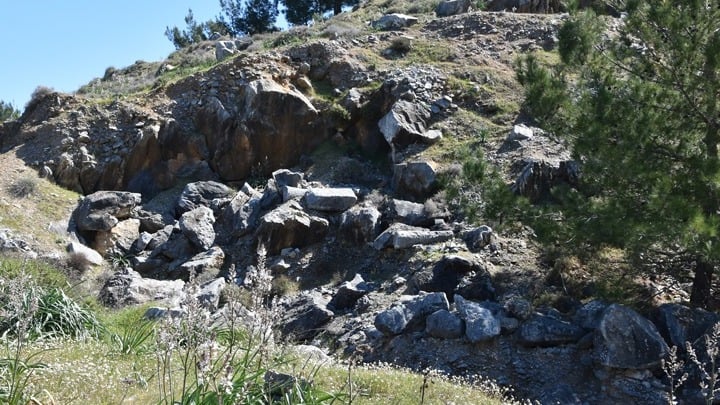Just four kilometers north of its city Mytileneon a hill on the car road to the village of Moria, It is one of the most impressive and at the same time unknown ancient monuments. The marble quarry that from the Hellenistic to the times of late antiquity was supplied with gray marbles the construction of many monuments of ancient Mytilene, such as the ancient theater of the city and the Roman aqueduct. But also in many areas of the territory of the Roman Empire, from Rome itself to Asia Minor Pergamon. It is also reported that it has been widely used for the construction of statues, such as the Aphrodite of Capitol, Giulia Pia, located today in the Vatican Museum and others. Marble It was also known as a “Lesbian stone” or in the Roman years as “Marmor Lesbium”.
“As shown in a map of the Mediterranean areas, released by Professor Lorenzo Lazzarini in 2002, the rock of Moria was transported and used in many monuments not only of Rome and other cities of Italy, but also throughout the Roman Empire,” Varta-Maranga Geologist, former researcher in IGME and a member of the Greek Department of ICOMOS.
The ancient marble quarry of Moria, easily visitedincludes nine basic mining cavities and many smaller in the periphery and occupies an area of 200 meters long, 120 meters wide and depth in certain points 30 meters.
For the extraction of materialas in most ancient quarries, they opened on the rock incisions with a scalable layout. Indeed, the traces of tools and technical quarrying on the rocks are evident on the surfaces of marble tumors. Inside these incisions were made of wedge holes for the placement of wooden wedges, which achieved the posting of parallelpes. The traces of the tools on the walls of the pit form the pattern of fish, or a herringbone, a characteristic of the quarries of Roman times.
The rest of the marble tumors processing throughout the monument indicate the large amount of the product produced. While the number of semi -workers who remain scattered and impress is very large.
Unfortunately, the aesthetic degradation of parts of the ancient quarry that has been described as a protected archaeological site is also impressed, but some use it to reject all kinds of rubbish. Also other parts of the monument that unfortunately has not been fenced by the modern mining activity that was interrupted just 50-60 years ago, and caused damage to its form, or by destroying lime semi-bourgeois.
‘The marble of her quarry Moria It is dark blue -collar, often with veins of crystalline structure in lighter gray to white, coarse -rough surface, not offered for polishing.
The crystalline limestone They are one of the oldest rocks and appear in many areas of Southeast Lesvos. These are rocks formed during the Triadian geological period, 200-250 million years ago, from sediments that were on the sidelines of the ocean of Tithos, the ocean that covered the region of present-day southern Europe and North Africa. In the crystalline limestones, in the area of Moria, impressive megalodon has been preserved, ”Mataranga said.
The ancient quarries, monuments of nature and man, from which the materials of the structure of the monuments and other masterpieces of art (statues and other sculptures) came, are undoubtedly a large national chapter of geological, archaeological and historical importance. That is why they are classified by a monumental value to the highest degree and therefore arise obligations of high degree of protection. In addition, in the Aegean, they become even more important. But they are also a very good educational example of ancient technology.
